If 2017 is the first year of blockchain and cryptocurrency, then 2018 is likely to be the year of convergence between blockchain and the Internet of Things. What are the results of the two most popular trends in the world?
The birth of the Internet of Things and blockchainInternet of Things
The concept of smart device networking in the Internet of Things was mentioned by students at Cameron University in 1982. The network Coke machine they developed can tell users whether there is inventory in the machine and whether the beverage is getting ice. The concept of the Internet of Things can be traced back to Bill Gates' 1995 book The Road to the Future. In the book of the future, Bill Gates repeatedly mentioned the interconnection of objects, but it was limited by the development of wireless networks, hardware and sensing devices, and did not attract attention. In 1998, the Massachusetts Institute of Technology creatively proposed the idea of ​​the Internet of Things, which was then called the EPC system. In 1999, based on item coding, RFID technology and the Internet, the US Auto-ID Center first proposed the concept of Internet of Things.
At this point, the concept of the Internet of Things was born. However, due to the development of sensor technology, network technology, and computer software technology, the Internet of Things has not been rapidly developed, but is steadily advancing in temptation:
In June 2000, LG launched the world's first network refrigerator, digital network DIOS.
In 2003 and 2004, the term IoT of the Internet of Things was mentioned in mainstream publications such as Guardian, ScienTIfic Americam, and the Boston Globe.
Some research projects such as Cooltown, Internet 0, and Disappearing Computer (DC) have advocated the idea of ​​implementing some IoT concepts, and the term Internet of Things has begun to appear in the title for the first time.
In 2005, the United Nations International Telecommunication Union (ITU) released the "ITU Internet Report 2005: Internet of Things" at the Tunis Information World Summit (WSIS), marking the entry of the Internet of Things into another level of development.
From 2006 to 2008, the Internet of Things began to receive EU recognition and held the first European Internet of Things Conference.
In 2008, the National Intelligence Council listed the Internet of Things as one of six “subversive civil technologiesâ€. At the same time, in addition to the European Union and the United States, other countries have also developed a strong interest in the Internet of Things.
In 2009, the Korea Communications Commission issued the "Basic Plan for Infrastructure Construction of the Internet of Things", which identified the Internet of Things as a new growth driver, and proposed to achieve "the world's most advanced IoT infrastructure implementation by 2012, to create a superb world of broadcast communication convergence." The goal of a strong ICT.
In 2009, Premier Wen Jiabao’s “Perceive China†speech pushed the research and application development of the Internet of Things in China to a climax.
After experiencing the exploration of pioneers in various fields, intelligent hardware, smart home, smart agriculture, smart transportation, smart security, smart education, smart industry, etc. have all developed relatively well. Of course, cloud computing, big data, and so on. The help of artificial intelligence and even edge computing.
With the integration of ICT technology in the Internet of Things and organic integration with OT, a complete upstream and downstream industry chain centered on the “Internet of Things platform†has been born: terminal core components (chips, modules, sensors and other underlying components), data transmission and communication. (wireless local area connection, wireless wide area connection, wired connection), horizontal capability platform (cloud service platform, operating system, universal interaction capability, Internet of Things security), application solution (consumer Internet of Things, industrial Internet of Things), industrial service (Association associations, test certification, standardization organizations, media, research institutions, investment institutions).
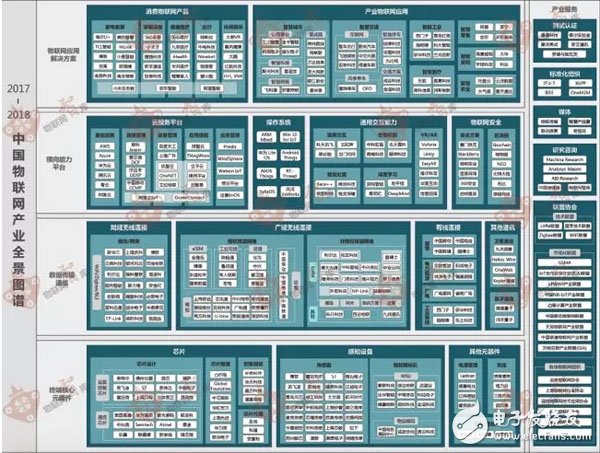
2. Blockchain
Blockchain is a new application mode of computer technology such as distributed data storage, point-to-point transmission, consensus mechanism, and encryption algorithm. Its history can be traced back to 1976, when Bailey W. Diffie and MarTIn E. Hellman, two masters of cryptography, published the paper "New Directions in Cryptography"; Hayek published the last book in his life. Monograph on economics: "Non-nationalization of money."
The two books, the former is the development guide for cryptography, and the latter is the spiritual guide for decentralized currencies. "The new direction of cryptography" covers all the new areas of progress in cryptography in the coming decades, including asymmetric encryption, elliptic curve algorithms, hashing, etc., which has laid the development direction of cryptography so far. It plays a decisive role in the technology of blockchain and the birth of Bitcoin; "Non-State of Money" proposes concepts such as non-sovereign currency and competition hairstyle currency.
With these two guidelines, the technology used in the blockchain is gradually evolving:
In 1977, the famous RSA algorithm was born, and the three inventors won the Turing Award in 2002.
In 1980, Merkle Ralf proposed the data structure and corresponding algorithm of Merkle-Tree. One of the main uses of the latter was the verification of the correctness of data synchronization in distributed networks, which was also introduced in Bitcoin for block synchronization. An important means of verification.
In 1982, Lamport proposed the problem of General Byzantine, marking the substantive theory and practice of distributed computing.
In the same year, David Jom proposed the cryptographic payment system ECash. It can be seen that with the progress of cryptography, the sharp-eyed people have begun to try to apply it to the field of money and payment. It should be said that ECash is a password. One of the earliest pioneers in learning currency.
In 1985, Koblitz and Miller independently proposed the famous elliptic curve cryptography (ECC) algorithm. Since the algorithm of RSA previously invented is too large to be practical, the ECC proposal really makes the asymmetric encryption system practical. Therefore, it can be said that in 1985, when the "new direction of cryptography" was published for about 10 years, the theoretical and technical basis of modern cryptography has been fully established.
During the period 1985-1997, there was no particularly significant progress in cryptography, distributed networks, and relationships with payments/money.
This phenomenon is easy to understand: at the beginning of the new ideas, ideas, and techniques, there is always a long time for everyone to learn, explore, and practice, and then there may be breakthrough results. The first ten years are often the development of theory, and the last ten years have entered the stage of practical exploration. The time of 1985-1997, about ten years, should be the stage of rapid development of relevant fields in practice. Finally, from 1976 onwards, after about 20 hours, the field of cryptography and distributed computing finally entered an outbreak period.
In 1997, the HashCash method, which was the first generation of POW (Proof of Work) algorithm, was invented mainly for anti-spam. In the various papers published later, the specific algorithm design and implementation has completely covered the POW mechanism used by Bitcoin.
In 1998, the complete idea of ​​cryptocurrency finally broke out. Wei Dai and Nick Saab also proposed the concept of cryptocurrency. Among them, Dai Wei's B-Money is known as the pioneer of Bitcoin, and Nick Saab's Bitgold outline is very similar to the characteristics listed in Nakamoto's Bitcoin paper, so that some people once suspected that Saab is Nakamoto. Interestingly, this distance has been the birth of bitcoin for a full 10 years.
On the occasion of the 21st century, there have been several major advances in the area related to blockchain: first, point-to-point distributed networks. During the three years from 1999 to 2001, Napster, EDonkey 2000 and BitTorrent appeared one after another. The basis of P2P network computing.
Another important thing in 2001 was that the NSA released the SHA-2 series of algorithms, including the most widely used SHA-256 algorithm, which is the hash algorithm eventually adopted by Bitcoin. It should be said that in 2001, all the technical foundations of the birth of bitcoin or blockchain technology were solved in theory and practice, and bitcoin was ready to come.
In November 2008, Nakamoto published a famous paper "Bitcoin: Peer-to-Peer Electronic Cash System". In January 2009, he used his first version of the software to dig out the founding block, which contained this sentence: The TImes 03/Jan/2009 Chancellor on brink of second bailout forbanks.", like the magic spell, opened the era of Bitcoin.
The follow-up history is very close to us. For example, the “Bitcoin purchase of pizza†event marks the gradual gain of recognition from the public. With the gradual improvement of the blockchain technology, there are intelligent contracts represented by Ethereum and blockchain applications that conform to different scenarios. Major companies, including Internet giants, communications operators, traditional enterprises, and startups, have begun to develop blockchains, building public chains, alliance chains, private chains, sidechains, and interconnected chains based on business needs. Due to the decentralization of blockchain, it brings openness, transparency, traceability and other capabilities in finance, supply chain management, traceability, energy, logistics, culture, media, entertainment, industry, agriculture, Intellectual property, tourism, real estate, Internet of Things and other industries or fields have unique advantages.
Second, the integration of the Internet of Things and blockchain
As a general trend, the Internet of Things is not a new industry that exists independently, but a deep integration with traditional industries in different fields. It is a new ecological model formed by the Internet of Things to empower traditional industries. The Internet of Things has a wide range of application scenarios in different fields, such as car networking, smart home, smart lighting, smart city, smart grid, smart agriculture, smart industry, real estate, medical, education and so on. And in each scene, there are a large number of technology companies, including IBM, Google, Microsoft, BAT and other technology giants, China Mobile, China Telecom, China Unicom, Vodafone, AT&T and other communications operators, as well as communications equipment manufacturers Huawei, Cisco, Nokia, etc...
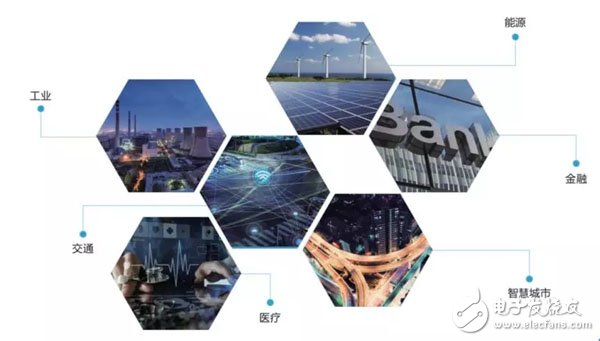
Around the entire IoT industry chain, from the sensing layer to the network layer to the application layer, there are continuous integration of industry giants and innovative enterprises, such as chip manufacturers Qualcomm, Intel, ARM, etc.; module manufacturers Gao Xinxing, Qi Jun shares, U-blox, Lierda, Fangfang Technology, etc.; Internet of Things cloud platform service providers Aila IOT, Wisdom Cloud, Yunzhiyi, Shugen Interconnect, etc.; general interactive capabilities Keda Xunfei, Face++, Yitu Technology, etc.; IoT security service providers Symantec, security, 360 security, Blackberry, etc.; consumer Internet of things are beautiful, Haier, Xiaomi, etc.; in the industrial Internet of Things, companies with better fields in different fields provide Internet of Things solutions, such as Philips, Siemens, Advantech, etc.
1. The development of the Internet of Things is blocked
With the breakthrough of technologies such as sensing technology, communication network and cloud computing, the development of the Internet of Things industry has been promoted. However, in the field of Internet of Things, there are also a series of bottlenecks and problems, which are manifested in the following aspects:
Hardware: Due to the different application scenarios of the Internet of Things, there are many types of sensors and their roles are different. In many sub-segments, there are problems of cost and scale; semiconductor materials, biotechnology, chip technology, and packaging required by hardware. The support of technology and other technologies will be limited by the upgrading of the technology; the inherent hardware equipment is too networked and intelligent, and the security design is insufficient.
Standard compatibility: The diversity of IoT devices, the differences in communication protocols, and the requirements of different application scenarios have led to inconsistencies in various standards in the Internet of Things: hardware protocols, data model standards, network protocols, sensor standards, device connectivity standards, and platforms. Compatibility, third-party application interfaces, service interfaces, etc. Inconsistent standards and standards can lead to waste of resources and various problems in device interoperability calls.
Data storage problem: At present, data collected after IoT device information is stored on a central server (cloud service), but as the number of networked devices increases in geometry, data transmission and storage costs, access efficiency, and performance stability In other respects, it will face a huge test.
Data analysis problem: At present, the processing of IoT device data after collection is only a simple data processing and service of equipment network management and operation status, lack of deep data mining and value application in enterprise to improve production efficiency, revenue, etc. aspect. This aspect will also be subject to the development of artificial intelligence and big data technology.
Industry application scenario: At present, the industry application scenario based on the Internet of Things is still in its infancy. After the smart device is connected, it has not improved people's lives and problems through intelligence. The consumer's will is not strong and there is no mature business model.
Security issues: The Internet of Things field has specific application scenarios in smart cities, transportation, energy, finance, home, medical, etc. In these scenarios, the number of connected devices and the amount of data transmitted by different types of devices will reach an unprecedented level. Height, its execution environment is different, and traditional network security defenses face enormous challenges. Security issues are manifested in two aspects, one is the impact of system attack and tampering on system security and personal life safety, and the other is data leakage. Once security issues arise in the IoT space, the harm will be enormous.
2. Blockchain emerges as the times require
Some people say that the blockchain is the Internet 2.0, which will trigger a new great revolution. Others think that its revolutionaryness is overestimated. Because the blockchain is still in the initial stage of development, it is difficult to see the direction of the future.
Throwing away all kinds of hype, the combination of the two hotspots of the Internet of Things and the blockchain is by no means a hot spot. There have been institutions predicting that the Internet of Things will be a fertile ground for the rapid development of the blockchain. This is not only because of the bottleneck of the development of the Internet of Things, but also because of the transaction sharing and non-destructive modification brought by the blockchain. The value transfer will bring a revolutionary improvement to the IoT service. The general performance of the blockchain will also help it shine in all walks of life.
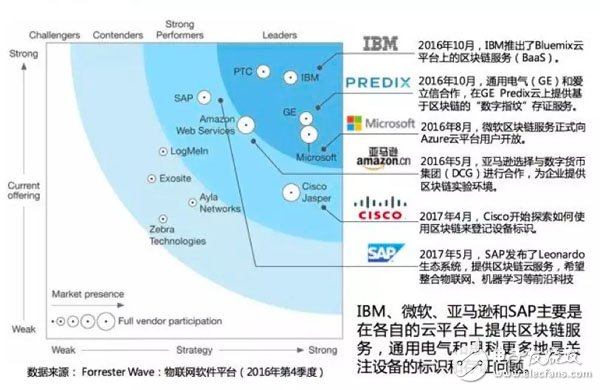
Internet of Things leaders have begun to lay out blockchains. IBM, Microsoft, Amazon, and SAP all provide Blockchain-as-a-Service on their respective cloud platforms, providing an elastic resource pool for future access to a large number of IoT devices.
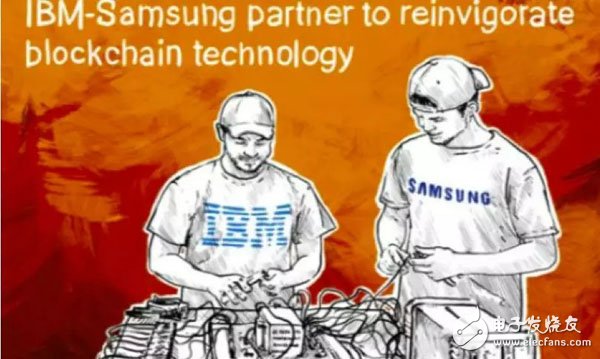
Intensive research on the Internet of Things for decades. In 2015, IBM launched the ADEPT (Autonomous Decentralized Peer-to-Peer Telemetry) project in 2015 to use Bitcoin to create a decentralized Internet of Things. , to provide the best security for the transaction.
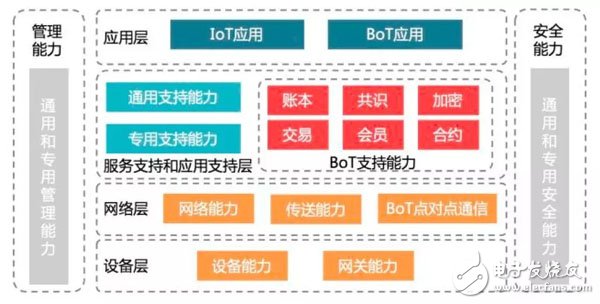
In March 2017, China Unicom and a number of companies and research institutes established the world's first Internet of Things (BOT) Blockchain of Things standard project in ITU-T SG20, defining a decentralized trusted IoT service platform framework. . ICT also completed the relevant project for the blockchain in the ITU-T SG 16 Working Group.
In addition, Microsoft, which did not develop well in the IoT era, also took the blockchain, the last bus, and entered the new track of the Internet of Things. Google, BAT, Huawei, Jingdong, Xiaomi, 360, etc. have also entered the blockchain field, exploring the application of blockchain and Internet of Things and other fields.
Third, what can the blockchain do for the Internet of Things?The blockchain has three characteristics: decentralization, trustworthiness and high security privacy. In the face of the explosive growth of IoT equipment in the future, the application of blockchain technology is expected to improve the pain points of the Internet of Things platform:
Reduce the cost of verification before the transaction: IoT blockchain application records the advantages of non-tamperability under the blockchain system. Users and devices under the platform do not need to verify the information of both parties, only need to judge the conditions given by the other party before the transaction. Whether it is different, the blockchain can be automatically executed through smart contracts and cannot be tampered with, ensuring that the transaction function can be completed without establishing a trusted relationship.
Reduce operational management costs: For the original IoT devices, all operations need to be processed by the central server, resulting in additional management, data communication costs and processing time. Through the blockchain point-to-point network technology, each node acts as a peer node, which can reduce the cost without additional protocol, hardware support and data communication processing costs for peer-to-peer interaction.
Protect data security and privacy: In the blockchain system, all data transmission is handled through strict encryption and communication through a peer-to-peer network, without the need to delegate data information to third parties in the transaction. And according to the characteristics that the information in the blockchain cannot be falsified, it is possible to judge whether the data information is stolen by checking the time stamp of the transaction record, thereby ensuring data security and privacy protection.
What kind of spark will the combination of the two popular concepts of the Internet of Things and the blockchain? This seems to be no longer limited by industry and technology, but a problem of creativity. Therefore, the author believes that there will be more participants in this field in the future. Among them, “classical†IoT enterprises, traditional enterprises seeking digital transformation, and start-ups in the blockchain field will meet the challenges and opportunities of this industry change.
We desing and manufacturer various LCD Driver/controller for many brand LCDs to support VGA Input,HDMI Input,DVI Input,Video input.
OEM and ODM service is also available,we make the LCD driving board accroding to your request.Small MOQ and fast leadtime.
Displays real-time data for your controller. In addition to current-voltage, current and temperature also limit information about the state of applications and controllers.
Thin-film transistor liquid crystal display (TFT-LCD) has the characteristics of light weight, flat plate, low power consumption, no radiation, excellent display quality, etc. Its application field is gradually expanding, has developed from audio-visual products, notebook computers and other displays to desktop computers, engineering workstation (EWS) monitors. LCD requirements are also developing towards high resolution and high color. Due to the CRT monitor and LCD screen has different display characteristics, both display signal parameters are also different, so the computer (or MCU) and LCD screen LCD driver circuit is required between design, its main function is through the electrode potential signal output to the LCD, peak modulation, frequency and other parameters to establish the ac drive electric field.
Lcd Driver,Lcd Driver Board,Lcd Controller Board,Universal Lcd Controller Board
TONYA DISPLAY LIMITED , https://www.tydisplay.com